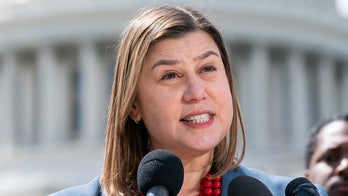
President Obama on Tuesday signed into law the largest spending bill in U.S. history, a package he pledges will save millions of jobs and bring the country back from the brink of economic catastrophe.
In doing so, the president marked a huge legislative victory less than a month into his term. He and Democratic congressional leaders won approval for the $787 billion plan late last week, despite having the support of just three Republicans in the Senate.
Obama said the package would not solve all the country's economic problems but would signify the "beginning of the end" of the recession.
"We have begun the essential work of keeping the American dream alive in our time," Obama said in Denver, calling the bill "the most sweeping economic recovery package in our history."
He said the federal government will send unprecedented levels of support into infrastructure, education, research, energy, health care and state government. He pledged to enact the bill with an "unprecedented level of transparency and accountability."
The signing capped weeks of intense debate on Capitol Hill. Senate and House negotiators met last week to strip billions of dollars out of the package -- which at one point approached $900 billion -- after both chambers initially passed conflicting versions of the bill. The final compromise measure passed Friday before midnight, meeting Obama's Presidents Day weekend deadline.
The signing Tuesday was a victory for Obama, but critics said his handling of the negotiations also undermined and contradicted his calls for bipartisanship. Obama entered campaign mode to sell the package to the public, often criticizing Republicans for their lack of support along the way.
According to Colorado Gov. Bill Ritter, the president chose to sign the bill in his state because of Colorado's potential for renewable energy jobs. The stimulus package includes investments in renewable energy sources being developed in Colorado, including wind and solar energy.
The plan pumps money into infrastructure projects, health care, renewable energy development and conservation, with twin goals of short-term job production and longer-term economic viability.
It includes a $400 tax break for most individual workers and $800 for couples, including those who do not earn enough to pay income taxes. It dishes out tens of billions of dollars to states so they can head off deep cuts and layoffs. It provides financial incentives for people to start buying again, from first homes to new cars.
And it provides help to poor people and laid-off workers, with increased unemployment benefits and food stamps, and subsides for health insurance.
The unemployment rate is now at 7.6 percent, the highest in more than 16 years. Analysts warn the economy will remain feeble through 2009.
Republican lawmakers, meanwhile, largely balked at the economic package. It drew no GOP votes in the House and only three in the Senate, albeit vital ones. Many Republicans said it was short on cutting taxes and the spending measures didn't target the vast sums of money well enough toward short-term job creation, which was the major goal of the bill.
But with the economy shedding jobs, there was widespread consensus in Washington for some sort of stimulus, and fast.
Yet the government's action comes at a cost down the line.
Many private economists are forecasting that the budget deficit for the current year will hit $1.6 trillion, including the stimulus spending. That's about three times last year's shortfall, and such year-to-year deficits contribute toward a mounting national debt.
On Wednesday in Arizona, Obama will unveil another part of his economic recovery effort -- a plan to help millions of homeowners fend off foreclosure.
The Associated Press contributed to this report.




